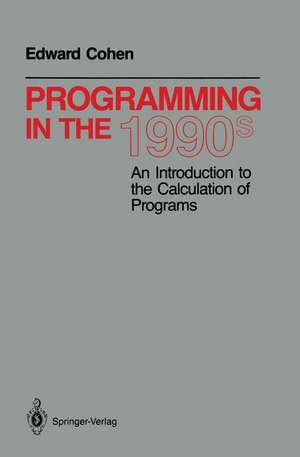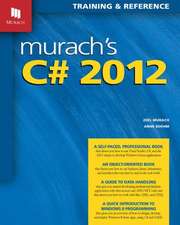Programming in the 1990s: An Introduction to the Calculation of Programs: Monographs in Computer Science
Autor Edward Cohenen Limba Engleză Paperback – 2 oct 1990
Din seria Monographs in Computer Science
- 20%
 Preț: 1322.33 lei
Preț: 1322.33 lei - 20%
 Preț: 511.92 lei
Preț: 511.92 lei - 20%
 Preț: 1285.31 lei
Preț: 1285.31 lei - 20%
 Preț: 328.60 lei
Preț: 328.60 lei - 15%
 Preț: 646.94 lei
Preț: 646.94 lei - 20%
 Preț: 357.48 lei
Preț: 357.48 lei - 20%
 Preț: 339.47 lei
Preț: 339.47 lei - 20%
 Preț: 653.21 lei
Preț: 653.21 lei - 20%
 Preț: 329.44 lei
Preț: 329.44 lei - 20%
 Preț: 993.74 lei
Preț: 993.74 lei - 20%
 Preț: 992.26 lei
Preț: 992.26 lei - 20%
 Preț: 1630.95 lei
Preț: 1630.95 lei - 20%
 Preț: 656.03 lei
Preț: 656.03 lei - 20%
 Preț: 650.08 lei
Preț: 650.08 lei - 20%
 Preț: 328.09 lei
Preț: 328.09 lei - 20%
 Preț: 641.16 lei
Preț: 641.16 lei - 20%
 Preț: 334.38 lei
Preț: 334.38 lei - 18%
 Preț: 737.74 lei
Preț: 737.74 lei - 20%
 Preț: 642.19 lei
Preț: 642.19 lei - 20%
 Preț: 641.99 lei
Preț: 641.99 lei - 20%
 Preț: 345.59 lei
Preț: 345.59 lei - 20%
 Preț: 711.29 lei
Preț: 711.29 lei - 20%
 Preț: 1001.16 lei
Preț: 1001.16 lei - 20%
 Preț: 661.47 lei
Preț: 661.47 lei - 20%
 Preț: 343.62 lei
Preț: 343.62 lei - 20%
 Preț: 644.81 lei
Preț: 644.81 lei - 15%
 Preț: 505.30 lei
Preț: 505.30 lei - 20%
 Preț: 640.69 lei
Preț: 640.69 lei -
 Preț: 396.78 lei
Preț: 396.78 lei - 18%
 Preț: 956.81 lei
Preț: 956.81 lei - 20%
 Preț: 592.68 lei
Preț: 592.68 lei - 20%
 Preț: 329.44 lei
Preț: 329.44 lei -
 Preț: 383.33 lei
Preț: 383.33 lei - 20%
 Preț: 349.40 lei
Preț: 349.40 lei - 20%
 Preț: 832.40 lei
Preț: 832.40 lei - 20%
 Preț: 993.42 lei
Preț: 993.42 lei - 15%
 Preț: 578.87 lei
Preț: 578.87 lei - 20%
 Preț: 337.85 lei
Preț: 337.85 lei - 20%
 Preț: 988.16 lei
Preț: 988.16 lei - 20%
 Preț: 996.56 lei
Preț: 996.56 lei - 20%
 Preț: 1293.37 lei
Preț: 1293.37 lei - 20%
 Preț: 1452.94 lei
Preț: 1452.94 lei
Preț: 333.22 lei
Preț vechi: 416.52 lei
-20% Nou
Puncte Express: 500
Preț estimativ în valută:
63.77€ • 69.24$ • 53.57£
63.77€ • 69.24$ • 53.57£
Carte tipărită la comandă
Livrare economică 23 aprilie-07 mai
Preluare comenzi: 021 569.72.76
Specificații
ISBN-13: 9780387973821
ISBN-10: 0387973826
Pagini: 265
Ilustrații: XV, 265 p.
Dimensiuni: 155 x 235 x 14 mm
Greutate: 0.44 kg
Ediția:Softcover reprint of the original 1st ed. 1990
Editura: Springer
Colecția Springer
Seria Monographs in Computer Science
Locul publicării:New York, NY, United States
ISBN-10: 0387973826
Pagini: 265
Ilustrații: XV, 265 p.
Dimensiuni: 155 x 235 x 14 mm
Greutate: 0.44 kg
Ediția:Softcover reprint of the original 1st ed. 1990
Editura: Springer
Colecția Springer
Seria Monographs in Computer Science
Locul publicării:New York, NY, United States
Public țintă
Lower undergraduateCuprins
0 What can we learn from a cake?.- 0.0 Introduction.- 0.1 What can we learn from a cake?.- 1 Preliminary notions, notations, and terminology.- 1.0 Introduction.- 1.1 The shapes of our calculations.- 1.2 Laws and so on.- 1.3 On avoiding parentheses.- 1.4 On carrying out calculations.- 1.5 Three new arithmetic operators.- 1.6 The problem with the three dots.- 1.7 What are the natural numbers?.- 1.8 A bit about function application.- 1.9 What next?.- 2 Predicates A — Boolean operators.- 2.0 Introduction.- 2.1 The equivalence.- 2.2 The disjunction.- 2.3 Intermezzo on some interesting formulae.- 2.4 The conjunction.- 2.5 The implication.- 2.6 The consequence.- 2.7 The negation.- 2.8 The discrepancy.- 2.9 Summary of binding powers.- 2.10 Final comments.- 2.11 Exercises.- 3 Predicates B — Quantified expressions.- 3.0 How to write quantified expressions.- 3.1 Laws for quantified expressions.- 3.2 Universal quantification.- 3.3 Existential quantification.- 3.4 Some arithmetic quantifications.- 3.5 Other quantified expressions.- 3.6 Additional exercises.- 4 Specifications.- 4.0 Introduction.- 4.1 Assigning meaning to our predicates.- 4.2 Towards writing specifications.- 4.3 Examples of specifications.- 4.4 Intermezzo on the array.- 4.5 More examples of specifications.- 4.6 Intermezzo on ascending functions.- 4.7 Even more examples of specifications.- 4.8 Other notations for functional specifications.- 4.9 Comments on specifications.- 5 The shapes of programs.- 5.0 Introduction.- 5.1 The shapes of programs.- 5.2 When is a program correct?.- 5.3 A bit about wp.S.- 5.4 Defining wp.S for all programs S.- 6 Intermezzo on calculations.- 7 Developing loopless programs.- 7.0 Introduction.- 7.1 Calculating expressions in assignments.- 7.2 Developing IFs.- 8 Developing loops — anintroduction.- 9 Loops A — On deleting a conjunct.- 9.0 Introduction.- 9.1 An example — Integer-division.- 9.2 An example — The linear search (and its billions of uses).- 9.3 An example — 3-tuple sort (and avoiding avoidable case-analyses).- 9.4 An example — Integer-division improved (and postponing design decisions).- 10 Loops B — On replacing constants by fresh variables.- 10.0 Introduction.- 10.1 An example — Evaluating a polynomial.- 10.2 An example — The minimum value.- 10.3 An example — Determining the multiple.- 10.4 An example — A table of cubes.- 10.5 An example — The maximum section sum.- 10.6 An example — The binary search (and its numerous applications).- 10.7 An example — Rearranging an array.- 10.8 An example — The bounded linear search.- 11 Mainly on recursion.- 11.0 Introduction.- 11.1 The general solution.- 11.2 An example — The sum of digits.- 11.3 An example — Exponentiation.- 11.4 Introducing four new types.- 11.5 An example — Reversing a sequence (and the importance of good notation).- 11.6 An example — The post-order of a binary tree.- 11.7 An example — The depth of a binary tree.- 11.8 Exercises.- 12 Back to scratch.- 12.0 Introduction.- 12.1 An example — Evaluating a polynomial (and the discovery of nice specifications).- 12.2 An example — Greatest common divisors (and the discovery of useful properties).- 12.3 An example — All shortest paths (and the specification as logical firewall).- 12.4 A final example — Shiloach’s algorithm.- 12.5 Additional exercises.- 13 Where to go from here.- 13.0 On what we have learned.- 13.1 Where to go from here.- 13.2 Be a little discriminating.- 13.3 Inspirations and acknowledgements.- 13.4 Selected references.- 13.5 If you find a nice example….














